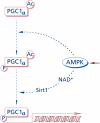Lipoic acid: energy metabolism and redox regulation of transcription and cell signaling
- PMID: 21297908
- PMCID: PMC3022059
- DOI: 10.3164/jcbn.11-005FR
Lipoic acid: energy metabolism and redox regulation of transcription and cell signaling
Abstract
The role of R-α-lipoic acid as a cofactor (lipoyllysine) in mitochondrial energy metabolism is well established. Lipoic acid non-covalently bound and exogenously administered to cells or supplemented in the diet is a potent modulator of the cell's redox status. The diversity of beneficial effects of lipoic acid in a variety of tissues can be mechanistically viewed in terms of thiol/disulfide exchange reactions that modulate the environment's redox and energy status. Lipoic acid-driven thiol/disulfide exchange reactions appear critical for the modulation of proteins involved in cell signaling and transcription factors. This review emphasizes the effects of lipoic acid on PI3K and AMPK signaling and related transcriptional pathways that are integrated by PGC-1α, a critical regulator of energy homoestasis. The effects of lipoic acid on the neuronal energy-redox axis are largely reviewed in terms of their outcomes for aging and age-related neurodegenerative diseases.
Keywords: AMPK; PGC1α; dihydrolipoic acid; energy; insulin; lipoic acid; mitochondria; redox.
Figures






References
-
- Reed LJ, De BB, Gunsalus IC, Hornberger CS., Jr Crystalline alpha-lipoic acid; a catalytic agent associated with pyruvate dehydrogenase. Science. 1951;114:93–94. - PubMed
-
- Patel MS, Packer L, editors. Lipoid acid. energy production, antioxidant activity, and health effects. Boca Raton: CRC Press, Taylor & Francis Group; 2008.
-
- Koh EH, Cho EH, Kim MS, Park JY, Lee KU. Effects of alpha-lipoic acid on AMP-activated protein kinase in different tissues: therapeutic implications for the metabolic syndrome. In: Patel MS, Packer L, editors. Lipoic Acid: Energy Production, Antioxidant Activity, and Health Effects. Boca Raton, Florida: CRC Press/Taylor & Francis Group; 2008. pp. 495–519.
Grants and funding
LinkOut - more resources
Full Text Sources
Other Literature Sources

